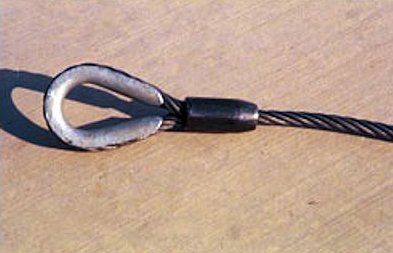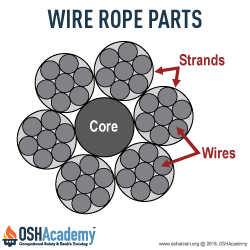Inspecting Suspension Ropes
- Check suspension ropes supporting adjustable suspension scaffolds to ensure they have a diameter large enough to permit proper functioning of brake and hoist mechanisms.
This wire rope has a thimble secured by an eyesplice, as required on the load end of suspension ropes.
- Make sure the use of repaired wire rope as suspension rope is prohibited.
- Ensure wire suspension ropes are not joined together except through the use of eye splice thimbles connected with shackles or coverplates and bolts.
- Make sure the load end of wire suspension ropes are equipped with proper-size thimbles, and secured by eyesplicing or equivalent means.
- Ensure competent persons are inspecting ropes for defects prior to each work shift, and after every occurrence which could affect a rope's integrity.
- Check that ropes are replaced when any of the following conditions exist:
- physical damage which impairs the function and strength of the rope
- kinks that might impair the tracking or wrapping of the rope around the drum or sheave of the hoist
- six randomly distributed wires are broken in one rope lay, or three broken wires in one strand in one rope lay
- loss of more than one-third of the original diameter of the outside wires due to abrasion, corrosion, scrubbing, flattening, or peening
- heat damage caused by a torch, or any damage caused by contact with electrical wires
- evidence that the secondary brake has been activated during an overspeed condition and has engaged the suspension rope
Knowledge Check Choose the best answer for the question.
5-9. When do scaffold suspension ropes need to be replaced?
You forgot to answer the question!


